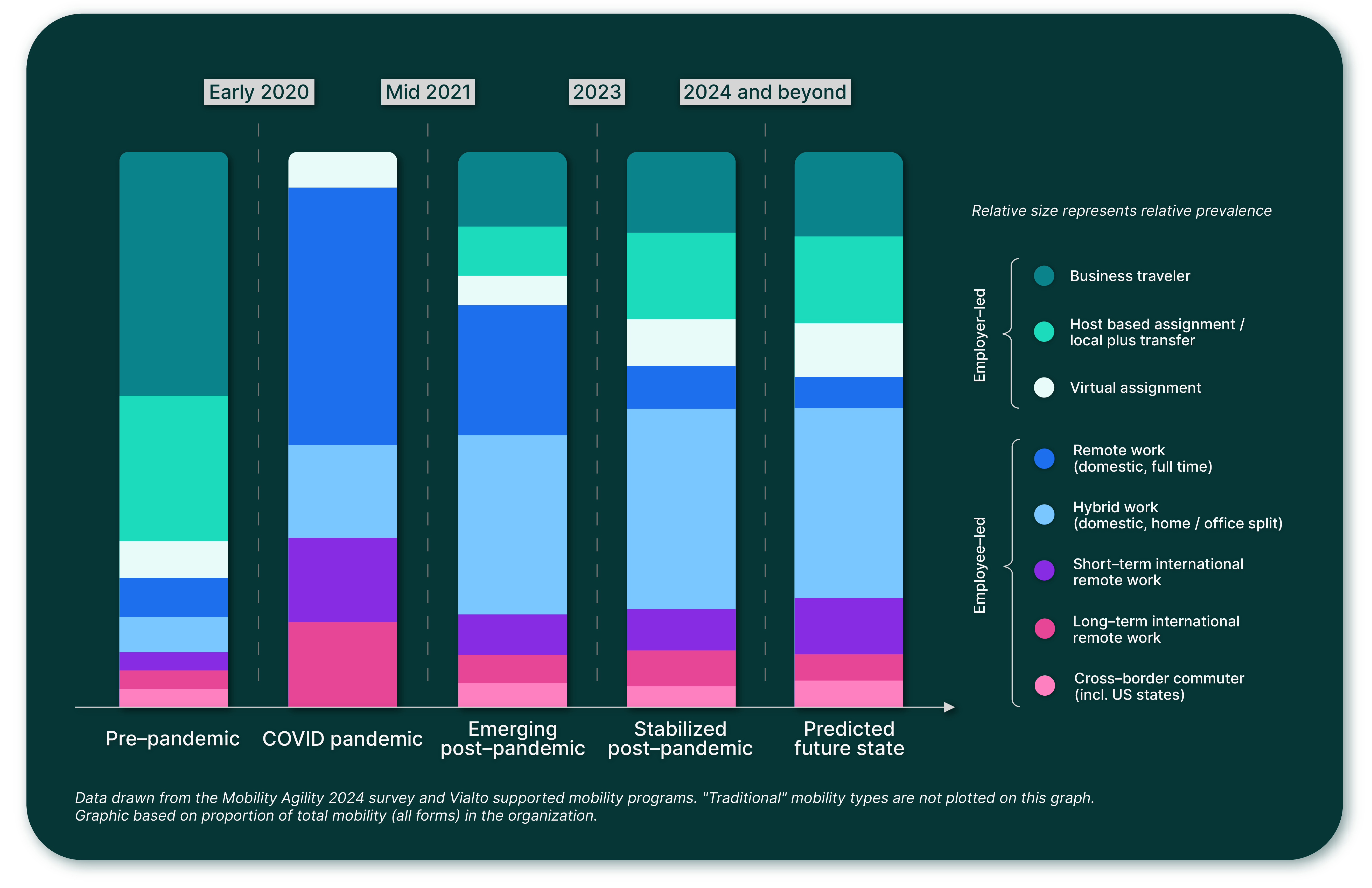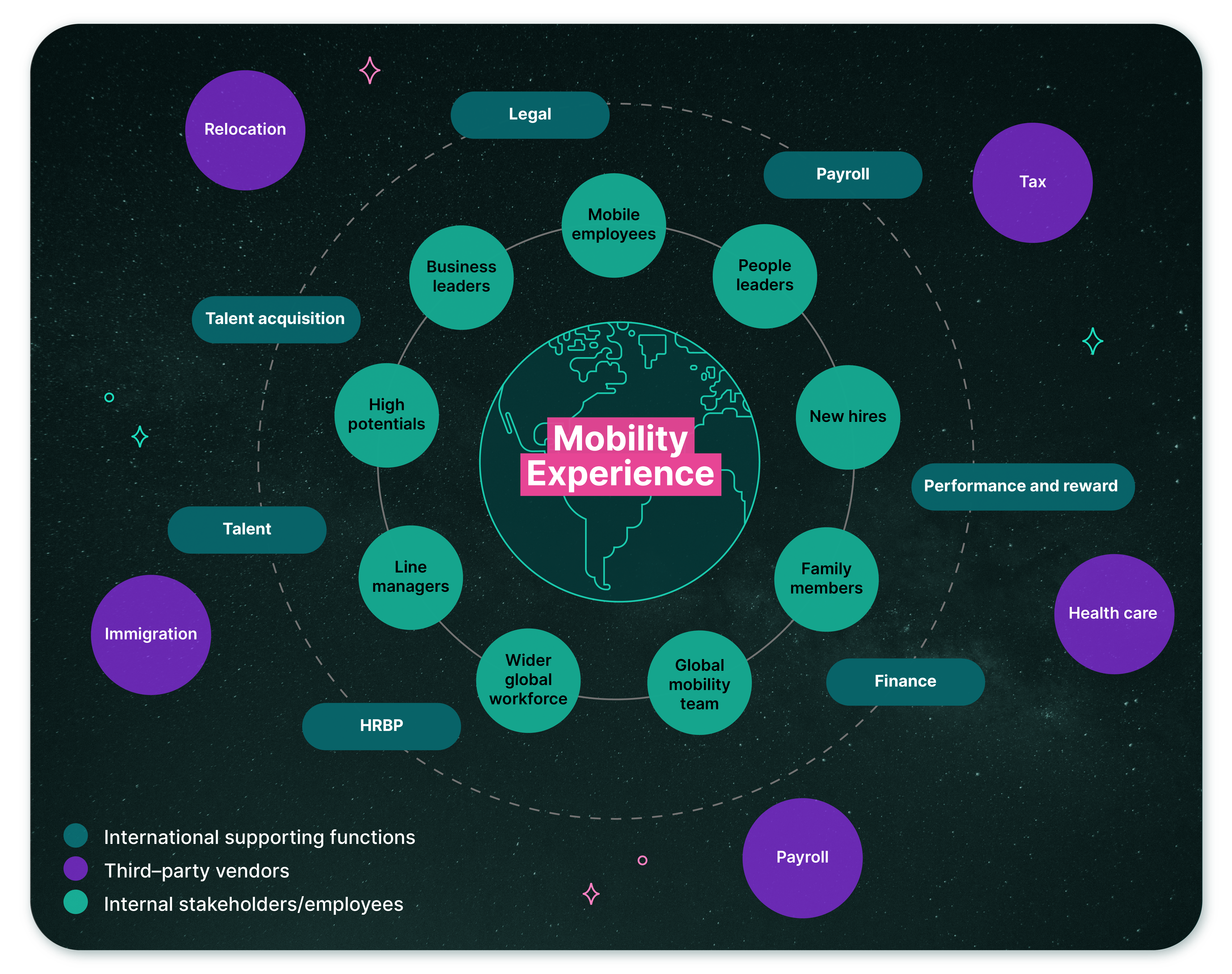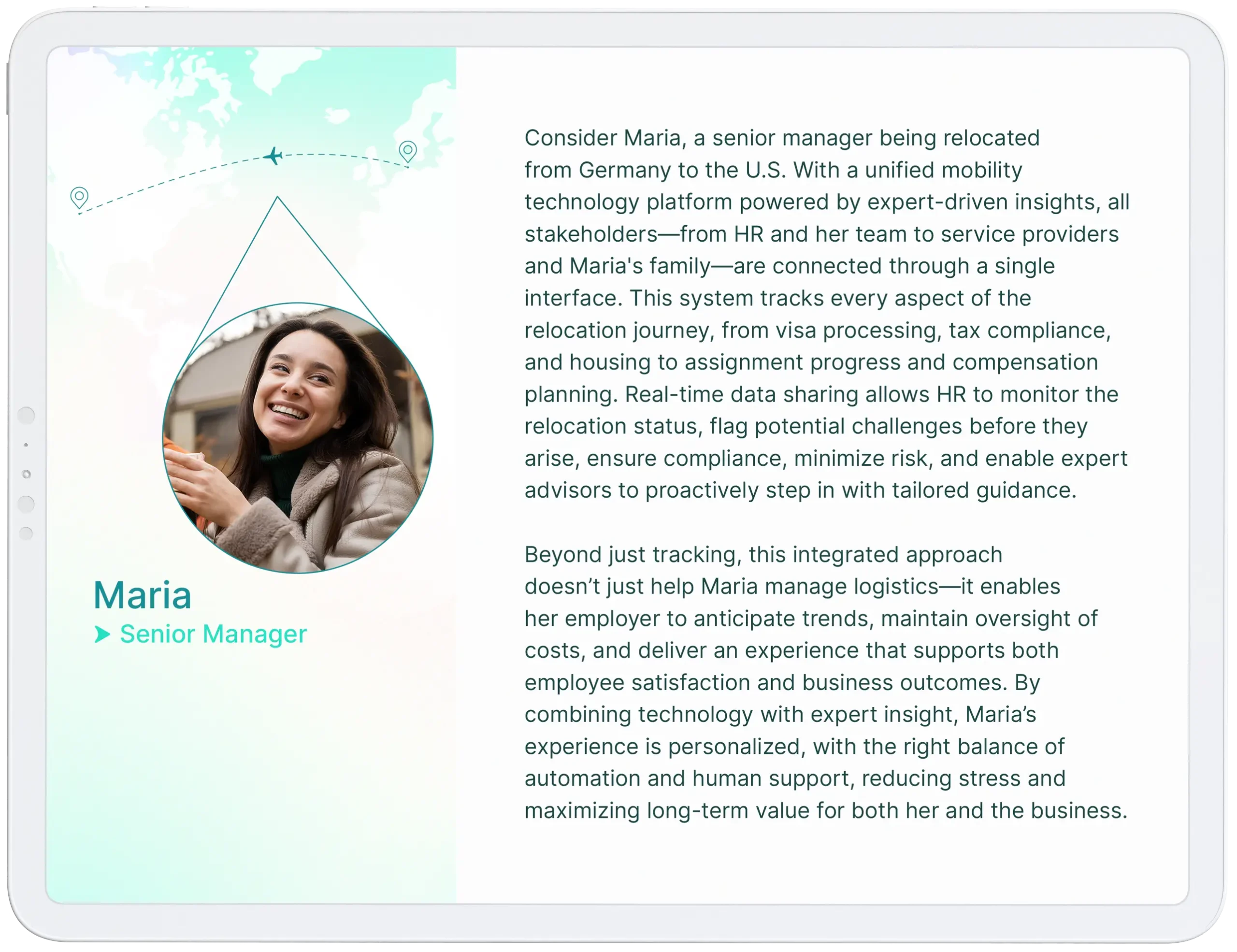Unless companies elevate the mobility experience, they risk falling short of rising employee expectations and undermining their talent investments. To move from “Adequate” to “Outstanding” and drive seamless, empowering mobility experiences, companies should build their mobility programs around three priorities:
- Consider every stakeholder in the mobility process—there might be more than you think.
- Adopt an empathetic approach to duty of care that goes beyond mere compliance.
- Use digital innovation and AI to transform mobility—but without losing the power of the human touch.
The definition of a positive employee mobility experience is evolving. Shifting societal norms, rapid technological advances, and the dynamics of a multigenerational workforce are driving higher expectations.
Mobility professionals are at the forefront of this change. They face rising employee demands alongside a rapidly transforming mobility landscape. The concept of being ‘mobile’ now includes short-term international remote work and virtual assignments, with external factors, from a changing regulatory landscape to sustainability considerations, reshaping traditional programs.
Five years since the COVID-19 pandemic started, we have arrived at a new normal for talent mobility. Today’s landscape is characterized by increases in flexible assignment types, such as virtual roles and short-term international remote work. Hybrid work continues to be key even while full-time remote work has seen a relative decline.

A November 2024 Gallup, Inc. study on U.S. jobs that can feasibly be carried out remotely, meanwhile, found that 55 per cent were hybrid, 26 per cent were exclusively remote, and 19 per cent were on-site1.
These shifts reflect the way employees’ preferences are changing, driven by technology or a desire for increased work-life balance, and considering the impact of remote working on their careers. Mobility programs should adapt to new style of thinking by emphasizing flexibility, personalization, and proactive support.
But how do the changes affect the end-to-end employee experience? And how can mobility teams elevate their programs from “Adequate” to “Outstanding”?
Mobility is not just logistics—it can be emotional
Working across borders can be exciting, but it could also bring emotional challenges. For employees and their families, relocation may not be just about logistics—in many cases it is a deeply personal, life-changing experience. Innate stressors such as decisions about new schools, adapting to new cultures, and managing new or high-pressure work situations can be compounded by unpredictable logistics, such as the timing of visas, housing arrangements, and myriad other uncertainties.
According to Vialto Partners’ 2023 Mobility (R)evolution: Redefining the Mobility Playbook2 survey, family concerns are a key barrier to a cross-border move. 62 per cent of the respondents said the potential negative impact on family life was a major reason to decline international assignments.
Career uncertainty is another reason employees hesitate with relocations: many employees worry about the status of their role upon returning from assignment. But only 38 per cent of organizations state they actively plan for repatriation roles 6‒12 months in advance, suggesting that many are failing to address this need for repatriation support3.
Beyond family and career, employees face practical worries such as the impact a relocation may have on their pensions or on a partner’s career. Employees tie these concerns and issues into the entire package of what they perceive as “my move” or “our move,” which underscores the need for a cohesive, supportive journey that supports an individual, couple, or family.
Without the right support, these challenges and concerns can undermine an employee’s performance. High performers might even turn down opportunities because of the stress they associate with mobility, which threatens the value of the organization’s investment in talent mobility.
Still, many mobility programs fail to prioritize continuous improvement; in fact, while 81 per cent of businesses gather employee feedback, only 23 per cent use feedback from mobile employees to enhance their programs. This suggests that businesses are not going far enough to stay updated on evolving needs of their mobile employees.
How to create an exceptional mobility experience
To maximize the value of investment in talent mobility, it is essential to create a highly polished experience. However, that is not to say that an exceptional experience is entirely “frictionless”. Instead, success comes from balancing efficiency with the right level of friction. Thoughtful pauses or controls aid in ensuring clarity and quality—helping organizations avoid the pitfalls of speed at the expense of sound decision-making.
Today, organizations can no longer settle for “Adequate”—“Outstanding” experiences are now the benchmark, delivering value for both employees (such as career advancement) and organizations (such as increased retention). Drawing from Vialto Partners’ extensive experience, we have identified three priorities that define a successful mobility program:
- Consider every stakeholder in the mobility process—there might be more than you think.
- Adopt an empathetic approach to duty of care that goes beyond mere compliance.
- Use digital innovation and AI to transform mobility—but without losing the power of the human touch.
Priority one: Consider every stakeholder in the mobility process—there might be more than you think.
The first step is to understand the current process. This means evaluating existing processes, identifying pain points, and defining the ideal experience with clear metrics for success. These metrics could include employee satisfaction and relocation efficiency.
Without metric insight, businesses cannot achieve a realistic view of satisfaction and engagement. Global research has found that only 23 per cent of employees say they are “engaged” with their work; 62 per cent are “not engaged” and 15 per cent are “actively disengaged”4.
It is also important to recognize that employees need more than just clear, accessible information—they need to feel cared for. Therefore, building trust and confidence into the entire process is essential.
Stakeholder mapping can help here. The range of stakeholders involved in mobility is extensive—from employees and their families to HR teams, line managers, and external partners. Understanding these groups and their needs helps to ensure a seamless, supportive experience for everyone.

Priority two: Adopt an empathetic approach to duty of care that goes beyond mere compliance
“A meaningful mobility experience is one where the assignee feels that somebody cares for them and is looking out for them,” says Eileen Mullaney, Global Leader for Workforce Transformation and Managed Services at Vialto Partners. “It’s not about reacting to an incident but delivering an authentic and proactive relationship,” she states.
Stephen Park, of Schneider Electric’s International Mobility Centre, agrees, stating “The important factor is making sure there’s enough care and empathy in a program. But, if your mobility program already has that built in, then the next step would be to think about how an assignment could fit into someone’s career path and give them the opportunity.”
Empathy can require a change in mindset, culture, and leadership behaviors. Research has found that executives are sometimes uneasy about being empathetic—72 per cent of CEOs said they would be challenged on decisions if they used empathy, and 55 per cent of HR professionals said the same. Sixty-nine per cent of CEOs said that being empathetic would make them “a pushover,” and 39 per cent of HR professionals shared this view5.
Practicing empathy, however, has significant upside. A best practice approach is to facilitate a proactive approach that goes beyond compliance, which can reduce assignment-related stress and improve retention and assignment success rates. For example, integrating wellness and career development into mobility programs to help employees feel supported, valued, and involved in long-term organizational goals.
Digital solutions can help companies to meet growing expectations around duty of care. Using advanced tools not only frees mobility professionals to focus on improving the program, it also gives them access to data-driven insights. Broadening the duty of care sounds expensive because it calls for new policies, procedures, and technology capability; however, data-driven insights can make a strong case for this investment. By assessing the cost-benefit ratio of enhanced policies, organizations can build a compelling case for broadening their duty of care. For example, analysis might track how investments lead to reduced employee turnover and retention costs.
Priority three: Use digital innovation and AI to transform mobility—but without losing the power of the human touch
To enhance employee experiences and streamline their processes, organizations should be using digital tools and technologies. Advanced digital platforms, for instance, can integrate data across vendors, reduce friction points, and provide employees with real-time information so they can make informed decisions throughout.
Artificial Intelligence (AI) technologies, such as generative AI, can automate routine tasks, track regulatory changes, and provide tailored compliance guidance. For example, AI-powered tools can model relocation scenarios, estimate costs accurately and efficiently, and simplify complex processes such as navigating tax obligations. Using AI can free up mobility professionals to focus on high-value activities such as giving employees personalized support.
A number of strategies can be considered to unlock the full potential of advanced digital technologies:
- Map employees’ pain points: Is your mobility data integrated enough to reduce friction for employees? Identify bottlenecks in processes where digital tools can simplify or enhance the experience.
- Integrate seamlessly: Are your technology platforms providing a unified experience? Reduce the complexity of managing multiple systems for both employees and mobility teams.
- Invest in upskilling: Are your teams confident using AI tools? Equip mobility professionals with the skills to deploy and manage digital tools effectively, balancing technological efficiencies with human expertise. A 2024 BCG study found that only 6 per cent of companies have already started upskilling workers on AI, and 59 per cent of leaders have limited or no confidence in their executive team’s generative AI proficiency6. It is time to address these gaps.
While AI has great potential for mobility, its role should complement—not replace—the empathy and technical expertise of mobility professionals. By automating routine tasks, organizations can empower professionals to focus on their strengths: giving employees personalized guidance that builds trust and meets their diverse needs.

The way forward: Create a seamless, personalized experience
Redesigning the employee mobility experience often requires organizations to take a fresh look at their vendor partnerships. For employees, their interactions with vendors should feel integrated—not like a disconnected series of outsourced tasks.
This kind of unified approach will help to align mobility efforts with an organization’s overall strategy. End-to-end solutions that enable data and support to flow effortlessly—from immigration and payroll to social security and tax—create a cohesive experience for the employee. Combined with a human touch that is empathetic and supportive, this frictionless approach sets the standard for exceptional mobility programs.
The benefits extend to employers too. Streamlined processes and integrated systems increase productivity. Reducing unnecessary complexity and providing greater data-driven insights, a unified approach helps mobility managers to demonstrate the success and value of their programs to the rest of the business.
By prioritizing holistic support, using cutting-edge technology, and showing employees empathy at every stage, organizations can transform employee mobility into an empowering, low-stress experience. The rewards—such as greater employee satisfaction, higher business value, and a stronger global presence—are worth the effort.
Learn more about Vialto Partners support
| Workforce Transformation | myMobility suite |
| Managed Services | Immigration Services |
Contact us
Eileen Mullaney
Global Leader
Workforce Transformation and Managed Services
Sharan Kundi
Global Leader
Immigration Services
Sarah Livitt
Leader, Global Strategic Communications
1 Gallup. (n.d.). Global Indicator: Hybrid Work. Gallup.com. Retrieved January 14, 2025, from http://gallup.com/401384/indicator-hybrid-work.aspx
2 Vialto Partners. (n.d.). Mobility (R)evolution: Redefining the Mobility Playbook. Retrieved February 12, 2025, from https://vialto.foleon.com/the-new-work-journey-survey/mobility-revolution/
3 Vialto Partners. (n.d.). Mobility (R)evolution: Redefining the Mobility Playbook. Retrieved February 12, 2025, from https://vialto.foleon.com/the-new-work-journey-survey/mobility-revolution/
4 Gallup. (2022). State of the global workplace: 2022 report. Retrieved January 14, 2025, from https://www.gallup.com/workplace/349484/state-of-the-global-workplace-2022-report.aspx
5 Businessolver. (2024). State of workplace empathy 2024. Retrieved January 14, 2025, from https://www.businessolver.com/workplace-empathy/
6 Loh, H.-H., Beauchene, V., Lukic, V., & Shenoy, R. (2024, October 8). Five must-haves for effective AI upskilling. Boston Consulting Group. https://www.bcg.com/publications/2024/five-must-haves-for-ai-upskilling
The information provided herein is for general informational purposes only and does not constitute legal, tax, or professional advice. Use of this information or website does not create a client or professional relationship. For tailored advice, consult a qualified professional. “Vialto Partners” is a trade name of CD&R Galaxy UK Opco Limited (“Vialto UK”) under which certain entities operate and provide professional services (each individually referred to as a “Vialto Partner”). Vialto Partners makes no warranties, express or implied, regarding the accuracy, completeness, or reliability of the content herein or otherwise, and disclaim all liability, including indirect or consequential losses, arising from reliance the information contained herein. Use of third-party links is for convenience only and does not imply endorsement or association. All content is the property of Vialto UK or its designated licensor and may not be reproduced or redistributed without permission. Reliance upon the information herein and the use of this site is at your own risk and subject to Vialto Partners Terms and Conditions of Use and Privacy Policy.
© 2025 Vialto Partners. All Rights Reserved.
Let's connect
Please reach out if you’d like to learn more about Vialto.